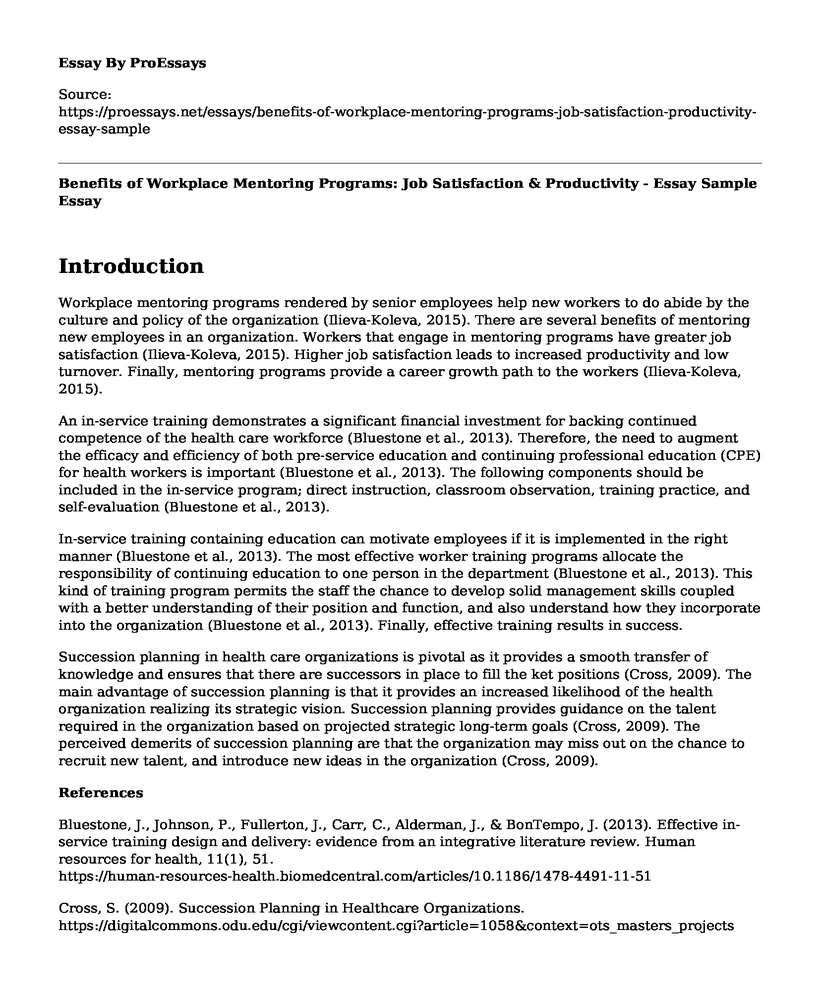Introduction
Workplace mentoring programs rendered by senior employees help new workers to do abide by the culture and policy of the organization (Ilieva-Koleva, 2015). There are several benefits of mentoring new employees in an organization. Workers that engage in mentoring programs have greater job satisfaction (Ilieva-Koleva, 2015). Higher job satisfaction leads to increased productivity and low turnover. Finally, mentoring programs provide a career growth path to the workers (Ilieva-Koleva, 2015).
An in-service training demonstrates a significant financial investment for backing continued competence of the health care workforce (Bluestone et al., 2013). Therefore, the need to augment the efficacy and efficiency of both pre-service education and continuing professional education (CPE) for health workers is important (Bluestone et al., 2013). The following components should be included in the in-service program; direct instruction, classroom observation, training practice, and self-evaluation (Bluestone et al., 2013).
In-service training containing education can motivate employees if it is implemented in the right manner (Bluestone et al., 2013). The most effective worker training programs allocate the responsibility of continuing education to one person in the department (Bluestone et al., 2013). This kind of training program permits the staff the chance to develop solid management skills coupled with a better understanding of their position and function, and also understand how they incorporate into the organization (Bluestone et al., 2013). Finally, effective training results in success.
Succession planning in health care organizations is pivotal as it provides a smooth transfer of knowledge and ensures that there are successors in place to fill the ket positions (Cross, 2009). The main advantage of succession planning is that it provides an increased likelihood of the health organization realizing its strategic vision. Succession planning provides guidance on the talent required in the organization based on projected strategic long-term goals (Cross, 2009). The perceived demerits of succession planning are that the organization may miss out on the chance to recruit new talent, and introduce new ideas in the organization (Cross, 2009).
References
Bluestone, J., Johnson, P., Fullerton, J., Carr, C., Alderman, J., & BonTempo, J. (2013). Effective in-service training design and delivery: evidence from an integrative literature review. Human resources for health, 11(1), 51. https://human-resources-health.biomedcentral.com/articles/10.1186/1478-4491-11-51
Cross, S. (2009). Succession Planning in Healthcare Organizations. https://digitalcommons.odu.edu/cgi/viewcontent.cgi?article=1058&context=ots_masters_projects
Ilieva-Koleva, D. (2015, May). The Importance of Mentoring Programs in Business. In Proceedings of International Academic Conferences (No. 1003018). International Institute of Social and Economic Sciences. https://ideas.repec.org/p/sek/iacpro/1003018.html
Cite this page
Benefits of Workplace Mentoring Programs: Job Satisfaction & Productivity - Essay Sample. (2023, Apr 01). Retrieved from https://proessays.net/essays/benefits-of-workplace-mentoring-programs-job-satisfaction-productivity-essay-sample
If you are the original author of this essay and no longer wish to have it published on the ProEssays website, please click below to request its removal:
- The Importance of Conducting Appraisals and Rewarding Employee Performance
- Essay Sample on On-the-Job Training (OJT)
- Corporate Social Responsibility of Tobacco Companies Paper Example
- Paper Example on TechFite: Promoting Leadership & Community Involvement
- Essay on Harrah's Corp: Loveman's Incentive Plan for Employee Motivation
- Essay Sample on Healthcare Industry Challenges: Population Growth, Unfunded Care & More
- Essay Sample on Prompt Response to OSHA Citations & Penalties







